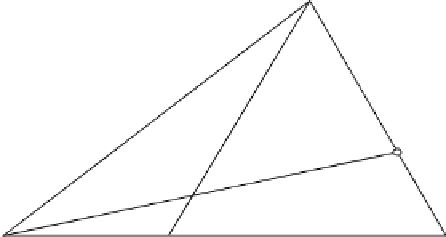Graphics Reference
In-Depth Information
Thus we can locate the points
D
,
E
and
F
using the vector equations
D
=
4
7
A
+
2
7
B
+
1
7
C
E
=
1
7
A
+
4
7
B
+
2
7
C
F
=
2
7
A
+
1
7
B
+
4
7
C
(11.13)
The important feature of these equations is that the barycentric coordinates
of
D
,
E
and
F
are independent of
A
,
B
and
C
; they arise from the ratio used
to divide the triangle's sides.
Although it was not the original intention, we can quickly explore what
the barycentric coordinates of
D
,
E
and
F
would be if the triangle's sides had
been 1:3 instead of 1:2. Without repeating all of the above steps, we would
proceed as follows.
The point
D
is on the intersection of lines
CC
and
AA
. Therefore, we
begin by placing a mass of 1 at
C
. Then, for line
BC
to balance at
A
amass
of 3 must be placed at
B
. Similarly, for line
AB
to balance at
C
amassof9
must be placed at
A
. This configuration is shown in Figure 11.22.
The total mass is 13 (1 + 3 + 9), therefore
9
13
A
+
3
13
B
+
1
13
C
D
=
1
13
A
+
9
13
B
+
3
13
C
E
=
3
13
A
+
13
B
+
9
1
13
C
We could even develop the general equations for a ratio 1:
n
.Itislefttothe
reader to show that
F
=
n
2
n
2
+
n
+1
A
+
n
n
2
+
n
+1
B
+
1
n
2
+
n
+1
C
D
=
1
C
3
A
¢
1
D
9
3
A
C
¢
B
1
3
Fig. 11.22.
The masses assigned to
A, B
and
C
to determine
D
.











